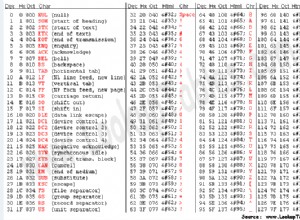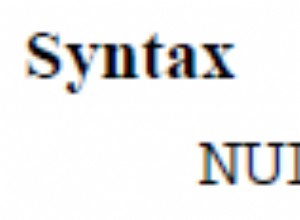मैंने ये ढूंढ निकाला। यह मेरे लिए काम करता है और उन सभी चीजों को कॉपी करता है जिनकी मुझे परवाह है।
CREATE PROCEDURE [dbo].[spCloneTableStructure]
@SourceSchema nvarchar(255),
@SourceTable nvarchar(255),
@DestinationSchema nvarchar(255),
@DestinationTable nvarchar(255),
@RecreateIfExists bit = 0
AS
BEGIN
/*
Clones an existing table to another table (without data)
Optionally drops and re-creates target table
Copies:
* Structure
* Primary key
* Indexes (including ASC/DESC, included columns, filters)
* Constraints (and unique constraints)
DOES NOT copy:
* Triggers
* File groups
* Probably a lot of other things
Note: Assumes that you name (unique) constraints with the table name in it (in order to not duplicate constraint names)
*/
SET NOCOUNT ON;
BEGIN TRANSACTION
--drop the table
if EXISTS (SELECT * FROM INFORMATION_SCHEMA.TABLES WHERE TABLE_SCHEMA = @DestinationSchema AND TABLE_NAME = @DestinationTable)
BEGIN
if @RecreateIfExists = 1
BEGIN
exec('DROP TABLE [' + @DestinationSchema + '].[' + @DestinationTable + ']')
END
ELSE
RETURN
END
--create the table
exec('SELECT TOP (0) * INTO [' + @DestinationSchema + '].[' + @DestinationTable + '] FROM [' + @SourceSchema + '].[' + @SourceTable + ']')
DECLARE @PKSchema nvarchar(255), @PKName nvarchar(255)
SELECT TOP 1 @PKSchema = CONSTRAINT_SCHEMA, @PKName = CONSTRAINT_NAME FROM INFORMATION_SCHEMA.TABLE_CONSTRAINTS WHERE TABLE_SCHEMA = @SourceSchema AND TABLE_NAME = @SourceTable AND CONSTRAINT_TYPE = 'PRIMARY KEY'
--create primary key
IF NOT @PKSchema IS NULL AND NOT @PKName IS NULL
BEGIN
DECLARE @PKColumns nvarchar(MAX)
SET @PKColumns = ''
SELECT @PKColumns = @PKColumns + '[' + COLUMN_NAME + '],'
FROM INFORMATION_SCHEMA.KEY_COLUMN_USAGE
where TABLE_NAME = @SourceTable and TABLE_SCHEMA = @SourceSchema AND CONSTRAINT_SCHEMA = @PKSchema AND CONSTRAINT_NAME= @PKName
ORDER BY ORDINAL_POSITION
SET @PKColumns = LEFT(@PKColumns, LEN(@PKColumns) - 1)
exec('ALTER TABLE [' + @DestinationSchema + '].[' + @DestinationTable + '] ADD CONSTRAINT [PK_' + @DestinationTable + '] PRIMARY KEY CLUSTERED (' + @PKColumns + ')');
END
--create other indexes
DECLARE @IndexId int, @IndexName nvarchar(255), @IsUnique bit, @IsUniqueConstraint bit, @FilterDefinition nvarchar(max)
DECLARE indexcursor CURSOR FOR
SELECT index_id, name, is_unique, is_unique_constraint, filter_definition FROM sys.indexes WHERE type = 2 and object_id = object_id('[' + @SourceSchema + '].[' + @SourceTable + ']')
OPEN indexcursor;
FETCH NEXT FROM indexcursor INTO @IndexId, @IndexName, @IsUnique, @IsUniqueConstraint, @FilterDefinition;
WHILE @@FETCH_STATUS = 0
BEGIN
DECLARE @Unique nvarchar(255)
SET @Unique = CASE WHEN @IsUnique = 1 THEN ' UNIQUE ' ELSE '' END
DECLARE @KeyColumns nvarchar(max), @IncludedColumns nvarchar(max)
SET @KeyColumns = ''
SET @IncludedColumns = ''
select @KeyColumns = @KeyColumns + '[' + c.name + '] ' + CASE WHEN is_descending_key = 1 THEN 'DESC' ELSE 'ASC' END + ',' from sys.index_columns ic
inner join sys.columns c ON c.object_id = ic.object_id and c.column_id = ic.column_id
where index_id = @IndexId and ic.object_id = object_id('[' + @SourceSchema + '].[' + @SourceTable + ']') and key_ordinal > 0
order by index_column_id
select @IncludedColumns = @IncludedColumns + '[' + c.name + '],' from sys.index_columns ic
inner join sys.columns c ON c.object_id = ic.object_id and c.column_id = ic.column_id
where index_id = @IndexId and ic.object_id = object_id('[' + @SourceSchema + '].[' + @SourceTable + ']') and key_ordinal = 0
order by index_column_id
IF LEN(@KeyColumns) > 0
SET @KeyColumns = LEFT(@KeyColumns, LEN(@KeyColumns) - 1)
IF LEN(@IncludedColumns) > 0
BEGIN
SET @IncludedColumns = ' INCLUDE (' + LEFT(@IncludedColumns, LEN(@IncludedColumns) - 1) + ')'
END
IF @FilterDefinition IS NULL
SET @FilterDefinition = ''
ELSE
SET @FilterDefinition = 'WHERE ' + @FilterDefinition + ' '
if @IsUniqueConstraint = 0
exec('CREATE ' + @Unique + ' NONCLUSTERED INDEX [' + @IndexName + '] ON [' + @DestinationSchema + '].[' + @DestinationTable + '] (' + @KeyColumns + ')' + @IncludedColumns + @FilterDefinition)
ELSE
BEGIN
SET @IndexName = REPLACE(@IndexName, @SourceTable, @DestinationTable)
exec('ALTER TABLE [' + @DestinationSchema + '].[' + @DestinationTable + '] ADD CONSTRAINT [' + @IndexName + '] UNIQUE NONCLUSTERED (' + @KeyColumns + ')');
END
FETCH NEXT FROM indexcursor INTO @IndexId, @IndexName, @IsUnique, @IsUniqueConstraint, @FilterDefinition;
END;
CLOSE indexcursor;
DEALLOCATE indexcursor;
--create constraints
DECLARE @ConstraintName nvarchar(max), @CheckClause nvarchar(max)
DECLARE constraintcursor CURSOR FOR
SELECT REPLACE(c.CONSTRAINT_NAME, @SourceTable, @DestinationTable), CHECK_CLAUSE from INFORMATION_SCHEMA.CONSTRAINT_TABLE_USAGE t
INNER JOIN INFORMATION_SCHEMA.CHECK_CONSTRAINTS c ON c.CONSTRAINT_SCHEMA = TABLE_SCHEMA AND c.CONSTRAINT_NAME = t.CONSTRAINT_NAME
WHERE TABLE_SCHEMA = @SourceSchema AND TABLE_NAME = @SourceTable
OPEN constraintcursor;
FETCH NEXT FROM constraintcursor INTO @ConstraintName, @CheckClause;
WHILE @@FETCH_STATUS = 0
BEGIN
exec('ALTER TABLE [' + @DestinationSchema + '].[' + @DestinationTable + '] WITH CHECK ADD CONSTRAINT [' + @ConstraintName + '] CHECK ' + @CheckClause)
exec('ALTER TABLE [' + @DestinationSchema + '].[' + @DestinationTable + '] CHECK CONSTRAINT [' + @ConstraintName + ']')
FETCH NEXT FROM constraintcursor INTO @ConstraintName, @CheckClause;
END;
CLOSE constraintcursor;
DEALLOCATE constraintcursor;
COMMIT TRANSACTION
END




